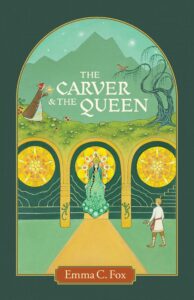 Summary: A retelling of a Siberian folktale.
Summary: A retelling of a Siberian folktale.
I have come to The Carver and the Queen because I have begun to follow the work of Owl’s Nest Publishers. It is a relatively new small publisher (about 2-3 years old). One of the founders is the author, KB Hoyle, and I am a big fan of her work. I have read her published novel-length works at least once. I have most enjoyed her fantasy Gateway Chronicles books, but I have also enjoyed her dystopian series (Breeder Cycle), the start of a science fiction series (Orion and the Starborn) and fairytale series (Son of the Deep) and her stand-alone book (Queen of Ebenezer). This has also led me to trust her judgment as an editor and publisher. I have started working through the other books that Owl’s Nest has published.
The Carver and the Queen is a retelling of a Siberian folktale I did not know. I have enjoyed the modern reimagining of folk tales that I did know, Orson Scott Card’s Enchanted, Neil Gaiman’s work, and Son of the Deep. But I am unaware of another book that was consciously retelling a folk story I did not know. I have not read Russian literature widely. But I have read some, both modern and older. This retains a Russian feel to my sensibility but does not feel too distant.
The story opens with Petr, a teenage orphaned serf, being beaten for losing some cows he was supposed to be watching. It wasn’t just the loss of the cows but the willingness to tell a magical reason for the loss and to keep to the story that led to such a severe beating. A teen girl, Lena, observes the beating, and when the boy and girl’s eyes meet, a connection is made, and experienced readers will know that this is, at heart, a romantic fairytale.
Young adult literature is almost always about youth’s naive optimism and bad decisions because they naively think that the bad things that happen to others won’t happen to them. Young adults are trying to find their way apart from the protection of the adults around them. It is a necessary part of growing up, but as an adult, I grieve the lousy decision-making of youth. I know it is a natural and necessary part of maturing, but still, I can see the pain it will cause and wish there was another way.
Petr is gifted and independent. He teaches himself to play the flute, which is what gets him into trouble in the first place. And then, after the beating, he is eventually placed as an apprentice of a stone carver as a punishment. But that too is something that he is very good at. Tragedy is all around. This is set in 18th or 19th century Siberia, and everyone lives hard lives. Death is common. Systems are corrupt and unfair. And magic has a price.
I enjoy reading young adult fiction, but as my kids get older, I have started to read it more through the eyes of a parent instead of through the eyes of a former teen. That doesn’t mean I enjoy it less, but I come at it differently. I have much more sympathy for the adults trying to protect and train the teens, and I wish the teens were more receptive to the well-meaning advice. I appreciate that young adult plotting keeps the story moving quickly, but there is still character development and young love, which are also essential parts of the genre.
One of the weaknesses of this book is that it needs a stronger sense of how communal identity was a self-protective feature of the culture. American individualism is still present in the book, and while all cultures have some individualism, I think the positive sense of communal identity needed a more significant role here.
I read this over three days of Thanksgiving break, and it was precisely the type of relaxing read I was looking for.
The Carver and the Queen Emma C. Fox Purchase Links: Paperback, Kindle Edition